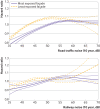Residential exposure to transportation noise in Denmark and incidence of dementia: national cohort study
- PMID: 34497091
- PMCID: PMC8424489
- DOI: 10.1136/bmj.n1954
Residential exposure to transportation noise in Denmark and incidence of dementia: national cohort study
Abstract
Objective: To investigate the association between long term residential exposure to road traffic and railway noise and risk of incident dementia.
Design: Nationwide prospective register based cohort study.
Setting: Denmark.
Participants: 1 938 994 adults aged ≥60 years living in Denmark between 1 January 2004 and 31 December 2017.
Main outcome measures: Incident cases of all cause dementia and dementia subtypes (Alzheimer's disease, vascular dementia, and Parkinson's disease related dementia), identified from national hospital and prescription registries.
Results: The study population included 103 500 participants with incident dementia, and of those, 31 219 received a diagnosis of Alzheimer's disease, 8664 of vascular dementia, and 2192 of Parkinson's disease related dementia. Using Cox regression models, 10 year mean exposure to road traffic and railway noise at the most (Ldenmax) and least (Ldenmin) exposed façades of buildings were associated with a higher risk of all cause dementia. These associations showed a general pattern of higher hazard ratios with higher noise exposure, but with a levelling off or even small declines in risk at higher noise levels. In subtype analyses, both road traffic noise and railway noise were associated with a higher risk of Alzheimer's disease, with hazard ratios of 1.16 (95% confidence interval 1.11 to 1.22) for road Ldenmax ≥65 dB compared with <45 dB, 1.27 (1.22 to 1.34) for road Ldenmin ≥55 dB compared with <40 dB, 1.16 (1.10 to 1.23) for railway Ldenmax ≥60 dB compared with <40 dB, and 1.24 (1.17 to 1.30) for railway Ldenmin ≥50 dB compared with <40 dB. Road traffic, but not railway, noise was associated with an increased risk of vascular dementia. Results indicated associations between road traffic Ldenmin and Parkinson's disease related dementia.
Conclusions: This nationwide cohort study found transportation noise to be associated with a higher risk of all cause dementia and dementia subtypes, especially Alzheimer's disease.
© Author(s) (or their employer(s)) 2019. Re-use permitted under CC BY-NC. No commercial re-use. See rights and permissions. Published by BMJ.
Conflict of interest statement
Competing interests: All authors have completed the ICMJE uniform disclosure form and declare: MLC and JHV report grants from the William Demant Foundation during the conduct of the study. JHV also received grants from Innovation Fund Denmark and William Demant Foundation, and a joined grant from Hearing aid Industry (Oticon, WSA, GN Hearing), outside the submitted work; no other support for the submitted work; no financial relationships with any organizations that might have an interest in the submitted work in the previous three years; no other relationships or activities that could appear to have influenced the submitted work.
Figures



Comment in
-
Noise exposure and dementia: a rising concern in ageing populations.BMJ. 2021 Sep 8;374:n2120. doi: 10.1136/bmj.n2120. BMJ. 2021. PMID: 34497051 No abstract available.
References
-
- Prince M, Comas-Herrera A, Knapp M, Guerchet M, Karagiannidou M. World Alzheimer Report 2016 - Improving healthcare for people living with dementia. London: 2016. https://www.alz.co.uk/research/world-report-2016
-
- European Environment Agency. Environmental noise in Europe - 2020. Luxembourg: 2020. https://www.eea.europa.eu/publications/environmental-noise-in-europe.
MeSH terms
LinkOut - more resources
Full Text Sources
Medical
Miscellaneous
